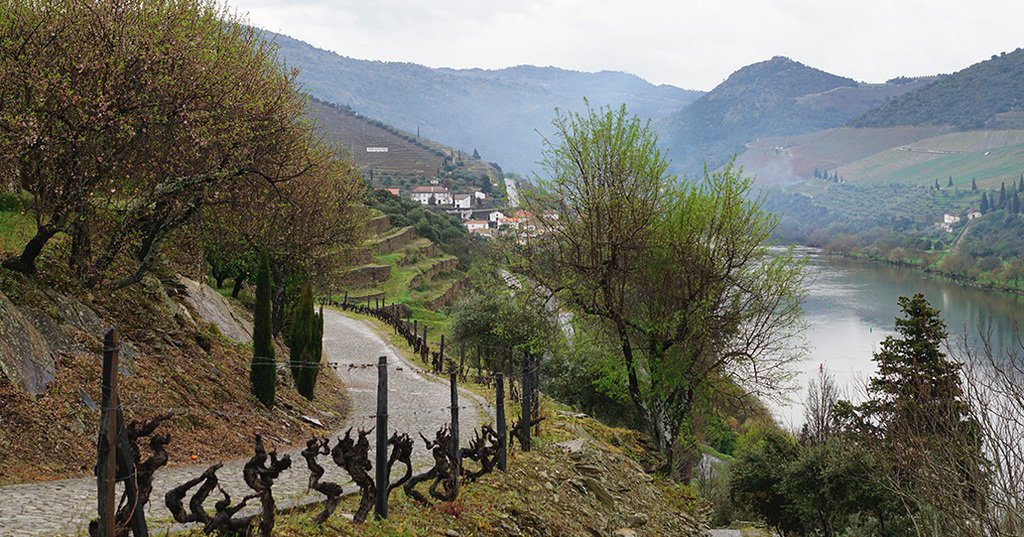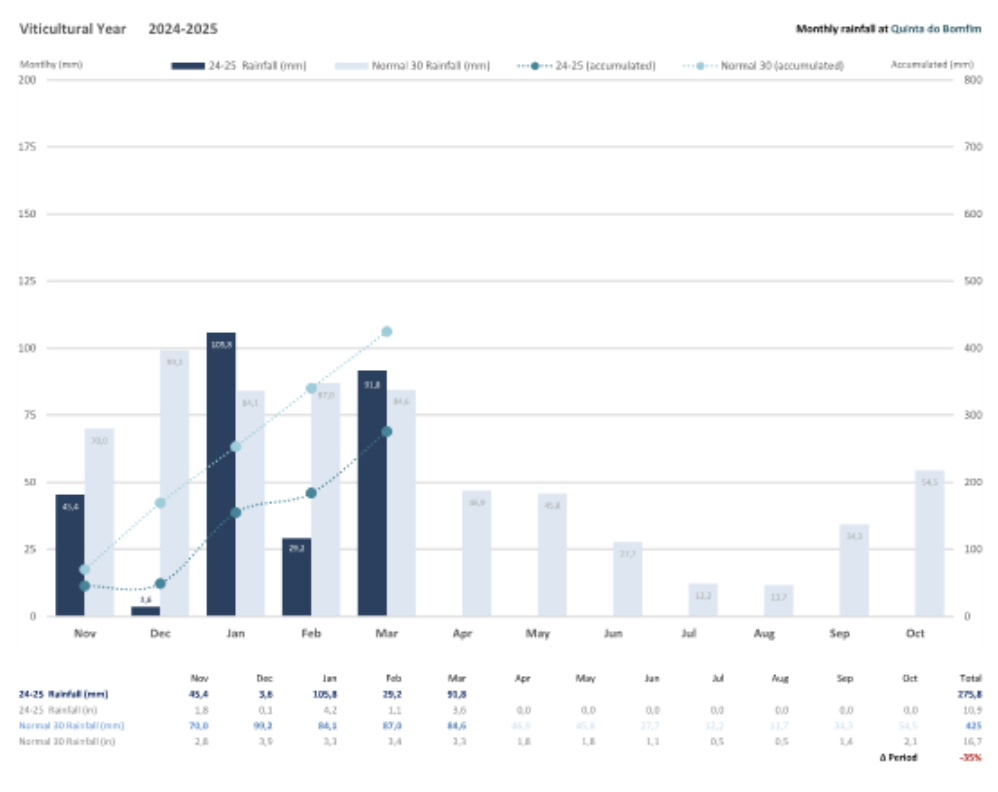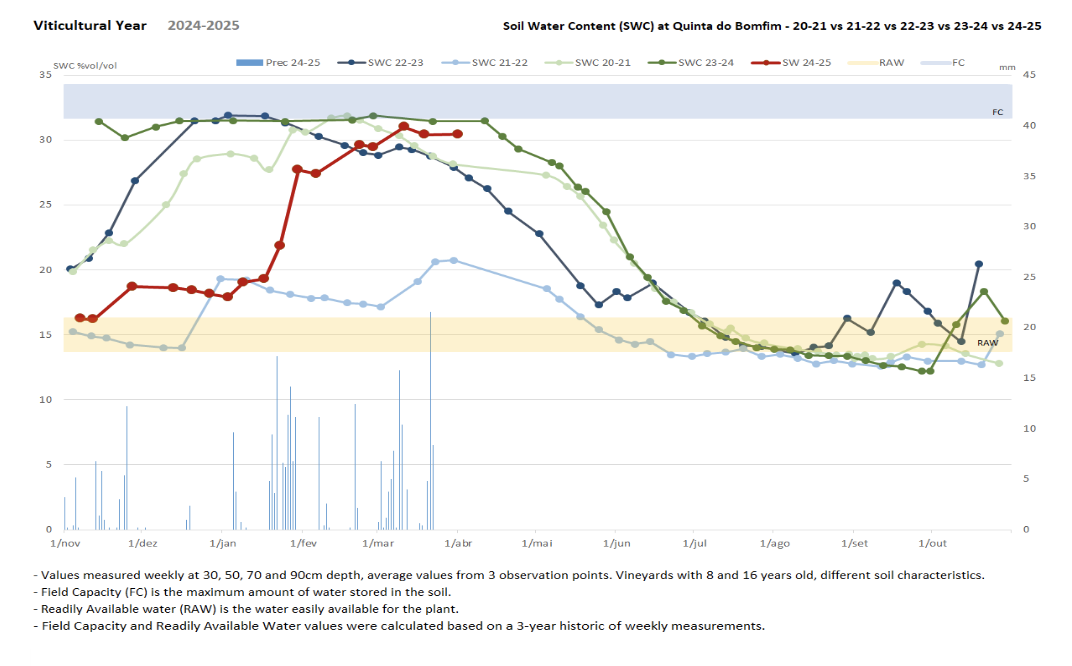
Viticulture Bulletin – Winter 2025
November 2024 - March 2025
Synopsis
Although winter rainfall in 2025 was not as abundant as in the winters of 2023 and 2024, both of which were above average (i.e. cumulative rainfall, between November and March), it was nonetheless reasonably wet overall. We had generous precipitation across the Douro, except during December, which was extremely dry (just 4% of the average for the month), and February with about half the normal levels. Through the season, temperatures were in the main close to average and a wet and relatively cool March translated into satisfactory water reserves in the soil. By winter’s end, the soil probes at Bomfim showed soil water content standing at 30.4%, which equates to field capacity - the maximum amount of water that the soil can hold (see fig. 2).
Fig.1: Quinta do Bomfim – Viticultural Year 2024/25 – Monthly rainfall

Monthly rainfall
Except for Canais and Malvedos, November rainfall was below the 30-year average across our quintas, and unseasonably mild temperatures were recorded across the board with Cavadinha and Malvedos both registering +3.1°C. In both of our vineyards outside the Douro – Quinta da Fonte Souto and Casa de Rodas – the rain fell short by about half compared to normal levels and as in the Douro, temperatures were noticeably warmer, +2.8°C in the Monção & Melgaço area and +2.2°C in Portalegre. According to the Portuguese Meteorological Office (IPMA), for Portugal as a whole it was the warmest November of the last 94 years and rather worryingly, the minimum temperatures continued their upward trend.
December was exceptionally dry in all three of the regions in which we farm, with practically zero rainfall in most of the Douro Superior quintas. Appreciable precipitation shortfalls were also observed at Casa de Rodas in the Minho, with a deficit of -83% (31.6mm compared to the 30-year average of 182.9mm). Likewise, Quinta da Fonte Souto in Portalegre recorded over 6 times less rain than normal. Fortunately, this absence of rainfall was mitigated by temperatures that were very close to average in all three regions.
By contrast, January brought abundant rain, with all our weather stations recording volumes above the monthly averages, most visibly outside the Douro with Quinta da Fonte Souto having more than double the mean rainfall and Casa de Rodas logging 246.4mm (95.8mm above the 30-year average). Unsurprisingly, soil water content by the close of the month (as measured at Bomfim) surged from the December reading of 18.2% to 27.7% - very near field capacity. All our weather stations also recorded above average temperatures, most notably in the Cima Corgo, with deviations of over 2°C and in Monção e Melgaço at +1.9°C.
February saw a return to lower precipitation with all our weather stations witnessing below average rainfall, a little below half across the Douro, one-third less in the Alentejo and just 14% less in the Minho. Temperatures were fractionally above normal in all three regions.
During March, there was a welcome return of good levels of rainfall, most prolifically at Quinta da Fonte Souto with three times the monthly average (180.6mm) and the Douro Superior with both Vale Coelho and Vesúvio having double the normal rainfall. Casa de Rodas was in line with this pattern, with 40% more rain than the 30-year mean. Perhaps in part due to the generous rainfall, temperatures in the Douro, Alentejo and Minho were mostly below the average for the month. In the Douro, March was the second wettest so far this century, second only to March 2018.
Budbreak: at Bomfim, budbreak for the Touriga Franca, occurred on March 26 - 12 days later than in the previous year, although in fact a week earlier than the 30-year average. The Touriga Nacional was similarly late — by 11 days — when compared to 2024, albeit just a week late compared to the average.
Conversely, at Ataíde budbreak was observed much closer to average dates for that area: two days early for the Franca (March 24) and aligned with the average for the Nacional (March 21).
The disparity in budbreak between the two locations (and indeed the delay at Bomfim) can be largely explained by the fact we started winter pruning later at Bomfim.
Fig.2: Quinta do Bomfim – Viticultural Year 2024/25 – Soil Water Content.

Fernando Alves, Miguel Potes and Joana Valente


